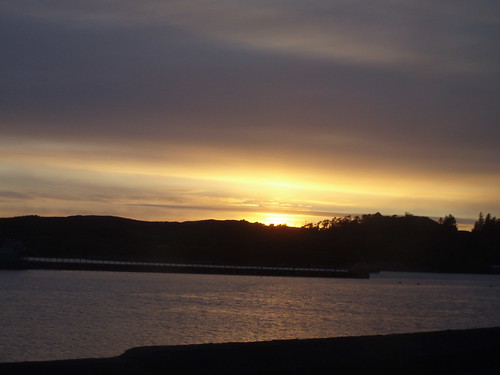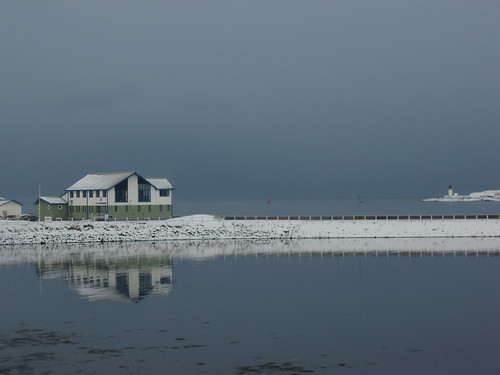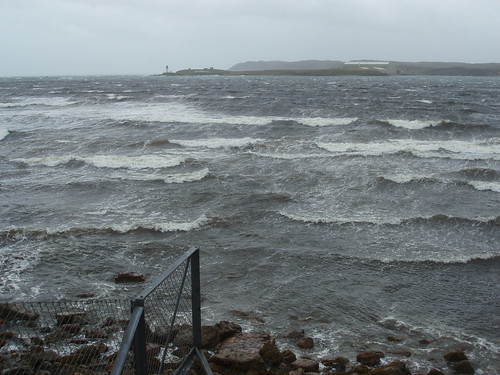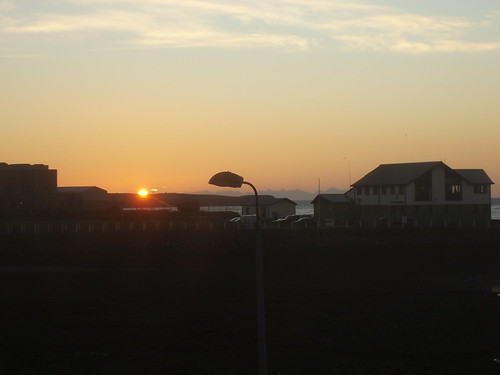Tonight, the final programme in the series on Harris Tweed was aired on BBC4. The outlook remained at best a questionmark, and not much short of gloomy. Rather than get hot under the collar, I'll restrict myself to putting down the way I think the industry should move forward - a purely personal take, not unduly burdened by excess knowledge.
Harris Tweed is a product, unique to the Outer Hebrides, and therefore unique to Scotland. Its production, as laid down by the trademark description, has to take place in the Outer Hebrides - exclusively. This is such a narrow remit, that it merits intervention at Government level (Scottish Government) to take the industry in hand.
Brian Haggas's ownership of the Kenneth Mackenzie Mill in Stornoway should be bought out. He has a stock of men's jackets, which he is pandering off through newspaper competitions, saucy photoshoots and what not. At the rate he is going, it'll take nearly a decade to shift the 70,000 jackets that clog up his warehouse. The KM Mill's production capacity is needed, in conjunction with that of Shawbost and Carloway's mills, to make the volume, necessary to reinvigorate Harris Tweed. Rather than being in competition with each other, Stornoway, Shawbost and Carloway should work under an overseeing body which directs the work of the mills.
The BBC4 programme showed that there is demand for Harris Tweed. This should be channeled to be produced in the Outer Hebrides, using the abovementioned overseeing body. Who should this overseeing body consist of? Weavers as well as mills, combined with the Harris Tweed Authority. A cooperative? Well, I don't know enough about that sort of thing.
I'll repeat what I said at the end of my previous post on this subject. The Kenneth Mackenzie Mill in Stornoway is the keystone to Harris Tweed. Without this, the cloth will be relegated to handbags and seatcovers. And Brian Haggas's jackets.
View across the Outer Harbour of Stornoway
Tuesday, 22 September 2009
Autumn 2009

Today sees the start of the northern hemisphere's autumn season, as the sun crosses the equator on its way south. The weather, as I already indicated in my previous post, is suitable for the time of year, at least here in the Western Isles. I am noticing the changing of the season also by the fact that the sun gets lower and lower in the sky. In my position, about 4 feet from the window, the sun does not reach me in the summer. It is beginning to do so now, and as the year progresses to its close, I'll have to close the curtains in the latter part of the morning - else I will not be able to read the screen.

Another sign of the changing of the seasons is seen in the behaviour of the starlings. Large groups of them are swirling around the town, but not nearly as large as the massive colonies of hundreds of thousands that are seen in southern England. One day, they'll all have gone south. To be replaced by individuals that have come in from higher latitudes to winter in the relatively mild climes of the Hebrides.

Winters here are not severe in terms of temperature. Your average daytime maximum will be around 7C / 45F, and frosts are not common. The lowest overnight temperature I've seen since 2005 is -6C, and that was in March. Snow too is not common either, with the deepest fall of 10 cm / 4 inches lasting exactly 24 hours on February 2nd, 2008.

What makes winters severe in the Western Isles is the wind. Last winter saw a storm with winds gusting to 110 mph, and January 2005 produced a hurricane with gusts to 135 mph. Even if these extremes are uncommon, gales are common: on average once a week will the wind blow at 40 mph or higher. High winds, and that need not necessarily be at galeforce, can persist for days on end, with low, grey clouds scudding by, with drizzle, rain and hail. Daylight hours are at a premium by December, with the sun rising at 9.15 am and setting at 3.35 pm.

Many people who see these islands in summer, under glorious blue skies see them at their best. Some may elect to come and live here. Not all can live through a Hebridean winter.
Tuesday 22 September
Changeable day in Stornoway, with frequent showers, a strong westerly wind and intermittent sunshine. Wind should abate after touching galeforce through the night and earlier this morning. Our freight ferry, the Muirneag, has not done its customary overnight crossing to and from Ullapool, leaving me thinking the shops will be empty today. The normal ferry is due in at 1.15pm, with supplies.
The River Clyde in Glasgow is the scene of a whale or dolphin rescue this morning. It was reported that a northern bottlenose whale of 5 metres / 17 feet in length had been spotted under a bridge a mile west of the city centre. Equipment is being brought it to aid with the rescue efforts.
The BBC reports that autism rates in children appear to be the same as those in adults, dispelling fears over the safety of the MMR vaccine. Ten years ago, a now discredited scientist published a report, linking MMR with autism in children. It led to a dramatic drop in the uptake of the measles, mumps and rubella vaccine, causing an upsurge in the incidence of those diseases. It is worth stressing that these 'childhood' illnesses can carry serious complications both in children and adults, and those can be life-threatening. Although the scientist behind the MMR scare has been discredited in his field, uptake of the vaccine continues to be below the rates what they were prior to 1998.
The River Clyde in Glasgow is the scene of a whale or dolphin rescue this morning. It was reported that a northern bottlenose whale of 5 metres / 17 feet in length had been spotted under a bridge a mile west of the city centre. Equipment is being brought it to aid with the rescue efforts.
The BBC reports that autism rates in children appear to be the same as those in adults, dispelling fears over the safety of the MMR vaccine. Ten years ago, a now discredited scientist published a report, linking MMR with autism in children. It led to a dramatic drop in the uptake of the measles, mumps and rubella vaccine, causing an upsurge in the incidence of those diseases. It is worth stressing that these 'childhood' illnesses can carry serious complications both in children and adults, and those can be life-threatening. Although the scientist behind the MMR scare has been discredited in his field, uptake of the vaccine continues to be below the rates what they were prior to 1998.
Subscribe to:
Comments (Atom)